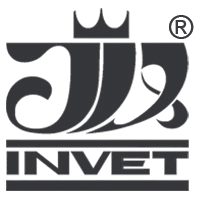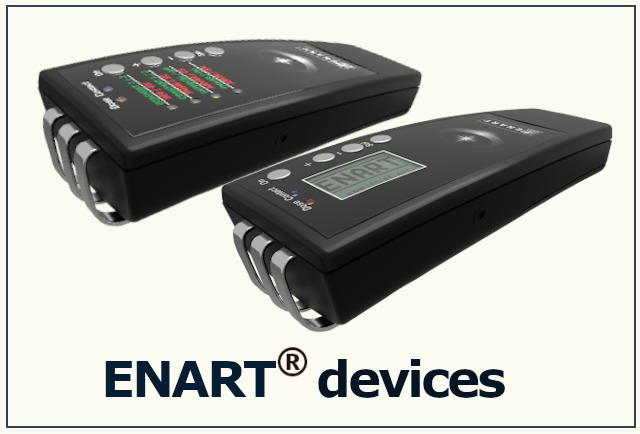By Dr Alan Byron MB. ChB MRCGP DPM.Merdrignac, France.
I am a medical doctor experienced a number of modalities of treating musculoskeletal problems and having received the ENART device in January of 2007 began a program of treatment on various volunteers. As the spectacular results of initial treatments became known amongst family, colleagues and friends there developed a rapidly exponential demand for treatment.
Although I treated a number of acute injuries with great success.
I looked for long term intractable problems that were at ‘end stage’ defying all conventional medical help as well as holistic interventions. These I felt would be more impressive than conditions that would be likely to improve with or without treatment having an anecdotal quality only.
Method of application:
I developed a system of use as follows:
I would run a diagnostic on the affected side and the healthier side. I would then make a treatment to both sides and then run again a diagnostic comparing the results on the affected side to the pre-treatment levels as well as the healthier side. All modalities including diagnostic time of dosing were considered important
General results.
There were consistent readings showing that the affected side always showed higher readings than the healthy side and that after treatment the readings on the affected side fell to approximate to those on the healthy side with rare exceptions, indicating balance had been restored.
These findings were consistent, repeated and therefore gave a good indication of the reliability of the machine.
As predicted in the instruction manual there was frequently an exacerbation of symptoms for a day or two that quickly resolved to an improvement.
I will describe some cases that demonstrate the efficacy of the machine. Many people are in ongoing treatment and their results are very encouraging.
Case 1.
RH is a Caucasian male aged 57. He has been an enthusiastic sportsman all his life and especially has enjoyed cricket for many years. His problem is that his left foot has become frozen, osteoarthritic and painful to walk on. This has resulted in the termination of his cricket career. He attributes his problem to his habit of banging down his left foot as he completes his bowling run in matches over the years.
On examination the left foot is much larger and arthritic than the right with some arch collapse. The ankle joint is virtually immovable as are the Metatarsal-phalangeal joints. Attempted flexion of the MTP joints produces considerable pain in this area. Dorsiflexion and plantarflexion of the ankle are difficult and painful.
He has completed a course of 4 treatments at weekly intervals.
Treatment type: ‘Constant’ with 100% deviation applied for 4 minutes to the dorsal MTPJ area and then the ventral. Then a slow sweep of the dorsal and ventral surface of the foot.
Results:
The very next day Mr H was delighted to notice that he had regained movement in his toes and there was very much less pain.
After each treatment there was a reduction in R1 OR1 & 2 and the time to zero dose with results becoming close to each other on both sides.
In subsequent treatments attention was supplied to the ankle and whole foot. After completion of 4 treatments Mr H was delighted to have regained considerable mobility in the ankle joint and toes.
He assessed his improvement as follows:
Pain = 80% better
Mobility= 60% better.
These results are impressive in that Mr H was considered to be severely osteoarthritic in his left foot with no hope of improvement. He has been advised to obtain an orthotic insole and perform regular massage on his feet to maintain his improvement.
He intends to return to cricket.
Case 2.
An acute problem: Success with just one treatment.
H.D. is a fit active woman of 44.
History:
After a highly stressful day of driving in exhausting conditions and witnessing a serious accident on the motorway she retired early to bed. The next day she complained of excruciating pain the right forearm, neck and shoulder. She had had a restless night in great pain.
On examination all movements of the hands, elbow, shoulder and neck were painful –especially on the right side. There was acute tenderness to palpation of muscles and joints with limited range of movement.
I considered the problem was acute musculo-skeletal fibromyalgia affecting the whole of the right upper limb and neck.
Treatment: A slow massage was performed with the ENART concentrating on the wrist, upper forearm, shoulder and neck; intensity 25% – no deviation – constant mode.
Result:
She slept well that night and the next day there was virtually no pain and after a month the pain has not returned.
Case 3.
SB is a very active lady of 60 who has supported her family physically and socially all her life. She has pain in both feet, left worse than right. She has used glucosamine & chondrotoin, fish oils, massage and reflexology as previous treatment.
On examination: There is a good range of movement in both feet and generally this lady is fit of slim build. She is very tender over the metatarsal heads left greater than right and there is some significant plantar fasciitis. She has a noticeable left lateral malleolar bursitis with talo-fibular tenderness. She has therefore ankle strain, metatarsalgia and subtalar arthritis.
Treatment: Two treatments have been completed with an initial quite uncomfortable exacerbation but settling well.
Table of result last treatment:
Times | Diagnostic Mode | Right (better foot) | Left (painful foot) |
| BEFORE TREATMENT Dorsal Metatarsal heads | R1 – Initial Reading | 25 | 49 |
| OR1 – 1st ongoing reaction | 43 | 70 | |
| OR2 – 2nd ongoing reaction @ ‘0’ – completion | 52 | 97 | |
| Time to zero dose | 60 secs | 64 secs | |
| Intensity | 35% | 35% | |
| AFTER TREATMENT | R1 – Initial Reading | 41 | 41 |
| OR1 – 1st ongoing reaction | 47 | 52 | |
| OR2 – 2nd ongoing reaction @ ‘0’ – completion | 53 | 63 | |
| Time to zero dose | 48 secs | 56 secs | |
| Intensity | 35% | 35% | |
| Treatment mode | Deviation | Intensity | Comments |
| Constant | 90% | 35 | Higher readings on left foot than right, and higher before compared with after on the left. Immediate improvement; less pain and better mobility. |
Result:
Further treatments are planned. Advised to obtain an orthotic device, carry on with massage and pay attention to the needs of the feet as registered and not ignore pain or tiredness.
Case 4.
JF is an active lady of 42 who has a weight problem: 15stone, height 5 foot 6.
History: 7 years ago she twisted left knee and was diagnosed with a damaged cruciate – as she reported to me. A week previously she had fallen downstairs and violently twisted her left knee again forcing it into flexion and abduction of the joint. She was confined to bed and in great pain a week later on consultation.
On examination: A careful examination of the knee revealed gross pre-patellar bursitis with extension into the coronal ligaments. Also the examination demonstrated quite definitely lateral semilunar cartilage damage. (A visit to her doctor confirmed that the earlier injury was to the cartilage and not the cruciate which was actually quite stable).
The joint line was tender laterally but not medially. Additionally she had severe large bursae of the medial and lateral aspects of the ankle.
Treatment: A preliminary diagnostic run showed a significant difference between the two joints in higher readings on the left. A sweep of the knee joint using constant mode, 20% intensity and 80% deviation for 5 minutes was effected. Balancing treatment was applied to the right knee. A follow up diagnostic showed the readings on both knees approximating to each other.
Result:
There was immediate reduction in pain followed by an aching sensation 2 hours later which lasted until the next day. Then there was a great reduction in pain and return in function. After three days she returned to work. A follow up treatment was preformed a week later, which resulted in a complete disappearance of symptoms and return of full function.
Case 5.
AB. A male physician of 72.
History: Many years of moderate untreated hypertension, raised cholesterol (8+ mmol) and stress. Noted on x ray 20 years previously to have aortic calcification but no treatment was offered. Always had healthy diet, regular exercise, normal height and weight, non smoker but father died aged 57 of ischaemic heart disease.
He developed severe angina in 1997 after post op blood loss to Hb. of 50% after major abdominal surgery.
Angiography demonstrated 90% occlusion of anterior descending coronary artery and up to 60% occlusion of other coronary arteries. He was given a quadruple heart by pass (CABG) in 1997 and maintained on aspirin 75mgm and atorvastatin 20 mgm. Annual appointments with cardiologist were offered.
In 2006 cardiac ultrasound noted some left ventricular hypertrophy.
He was on an ACE inhibitor with little symptomatic effect. He developed severe dyspnoea of effort on slight exertion and tachycardia on walking
one flight of stairs or after 25 metres on a gentle incline with a cardiac constriction sensation. He noted a most uncomfortable claudication sensation in the buttocks and hamstring areas on effort going upstairs. There was some ankle oedema indicating heart failure. His BP was 175/90, pulse 90 and regular.
Treatment: 10 treatments were given applying ENART to foot arteries, popliteal, femoral, and site of common iliac arteries on the lower abdomen. Also treatment was done over the heart mid-zone and in the neck over the carotids. Intensity in the feet was 80%, femoral 50%, common iliacs 40%, heart 40% and carotids 15%. ‘Constant’ settings with 100% deviation and about 5 minutes to each site giving about 40 minute treatment time. He was given about one or two treatments per week.
Result: There was a gradual and persistent symptomatic improvement. Symptoms of ischaemic claudication in the buttocks and posterior thighs diminished over the 10 weeks and revealed some calf claudication masked by the buttock pain. There was a significant diminution of dyspnoea of effort with breathlessness on effort down to about 20% of that previously. This was after three flights of stairs producing a transient tachycardia of only 100 for one minute. He is now able to walk briskly uphill on a moderate incline without difficulty; able to swim far more rapidly and recently able to swim an entire length under water.
Blood pressure now 145/75 and resolution of ankle oedema.
There is a considerable improvement in symptoms and zest for life.
I consider the ENART has reversed the ischemic changes occurring 10 years after CABG and reduced the possibility of early death.
There have been several other cases demonstrating an excellent response to treatment. These include:
a case of solar keratosis – premalignant- on the tip of the nose in a 45 year old woman. This completely disappeared after two treatments.
A case of a 50 year old chef with left tennis elbow resolved after one treatment.
A case of severe chronic viral throat infection with massive lymphadenopathy, pyrexia and fatigue in an 18 year old. There was 80% improvement the next day after throat treatment and 100% resolution after 2nd treatment a week later.
Alan Byron – 16th Feb 2007
 About Us
About Us Contact us
Contact us Delivery and payment
Delivery and payment

